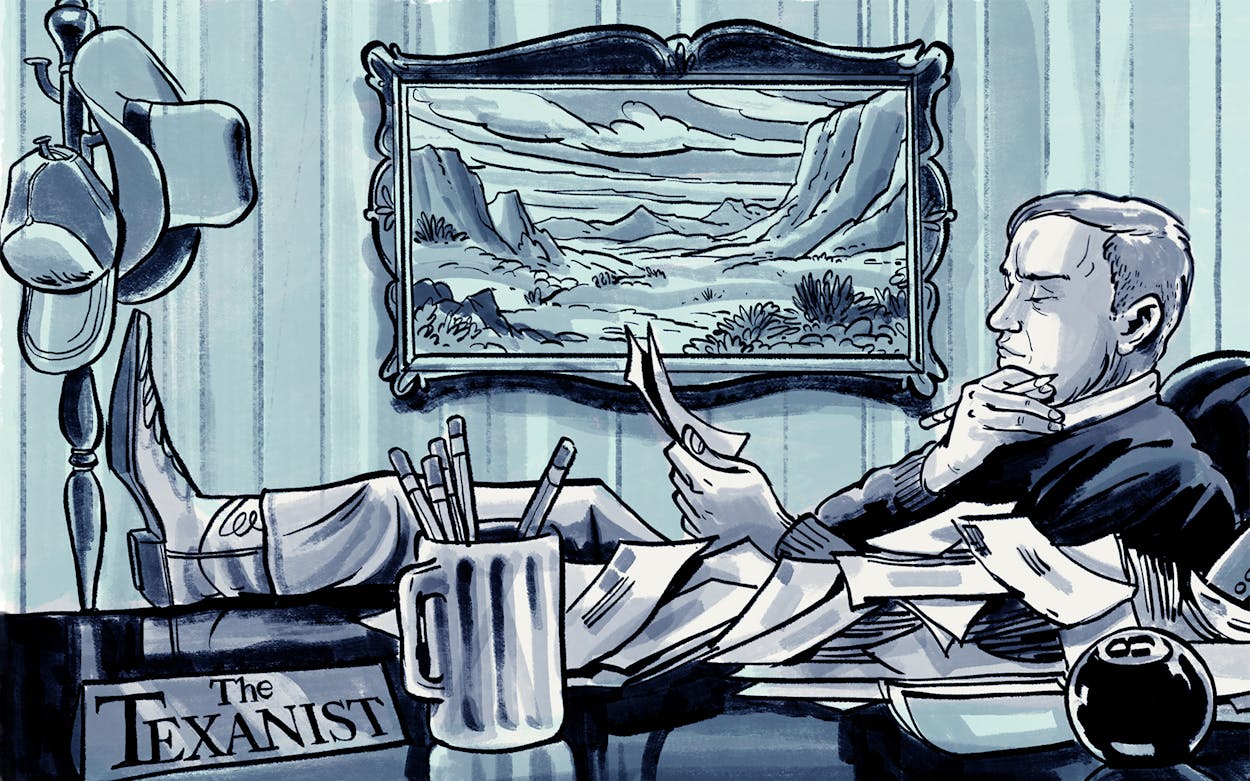Q: It’s that time of year again. The temperature barely dips below 32 degrees Fahrenheit and all the TV weather reporters invariably characterize the condition as a “hard” freeze. As a child I accepted this redundant description, but when I started traveling to other regions, I noticed a difference. In ski country and up north, the forecasters simply report 12 degrees or -2 degrees without offering any reminder that water freezes at 32 degrees. We Texans are quite familiar with the concept of ice in our tasty beverages, so my question is, why do Texas weather folk always say “hard” freeze?
Cecil Cole, Austin
A: The Texanist feels your pain, Mr. Cole. He was also once of a mind that TV weathercasters were too often overly sensational with regard to their recaps and outlooks—especially during the long and hot dog days of summertime, when the Texas weather can become downright monotonous. At times, it feels like insult is intentionally being added to injury.
In fact, back in August 2016, the Texanist, apparently weary of the unwavering heat, went off on the perpetrators of what he considered to be an exceptionally infernal utilization of the heat index. “Hey, meteorologists!” he wrote. “Enough with the damn heat index! ‘And we’re looking at a high of 101 degrees, but with the heat index it will feel more like 118.’ That’s like saying, ‘It’s going to be hotter than two rats making whoopee in a wool sock, but it will feel hotter than the devil’s nether regions.’ Or the other way around. Either way, it’s completely unnecessary. It’s hot. Can we just leave it at that?”
But then, some months later, after the arrival of that first blue norther, when the weather and the Texanist had both cooled down a little bit, he came to realize that the heat index, which takes the actual temperature and factors in the relative humidity to come up with a “feels like” temperature, does serve a purpose—namely, increasing the safety and well-being of his less-hardy fellow Texans—and he felt mildly remorseful for berating the well-intentioned weather folks.
The irritation with which you’ve come to the Texanist is a similar one. And just as it is with the heat index warnings, there is also, believe it or not, a legitimate distinction between a freeze and a hard freeze. It’s not, as you are probably thinking, just about the sexing up of the weather report.
Dr. John Nielsen-Gammon, a professor in the Department of Atmospheric Sciences at Texas A&M who has served as the state climatologist for nearly two decades, explained to the Texanist that a “hard freeze” occurs when the air temperature falls to 28 degrees or lower and then stays below 32 for long enough to freeze vegetation and cause ice formation in standing water. “The significance of a ‘hard freeze’ as opposed to a ‘freeze’ is mainly the impact on plants. It’s really more of an agricultural concern than a meteorological one,” Nielsen-Gammon said.
See, a forecast that calls for the temperature to hit 32 or 31 or even 29 degrees and then rise back above freezing fairly quickly doesn’t present as much of a threat to what are known as the Four P’s—plants, pets, pipes, and people—as does a forecast calling for temperatures to drop to, say, 25 and then stay below freezing for a good stretch. Whether a person happens to be a farmer in the winter garden of South Texas, a rancher in North Texas, or just a homeowner in Bastrop worried about the health of her hibiscus and the possibility of her toilet drain pipe bursting, a heads-up about such conditions can be quite useful.
You are correct, though, that weather reporters in more northern parts of the country are not as quick to use the term “hard freeze” as the weathermen and weatherwomen here in Texas are. This is simply because the folks up north, with their snow shovels and down-filled doggie jackets and bags of sidewalk-ice-melting salt, are on the alert throughout the winter months for such frosty conditions, and don’t need much of a goose to gear into action. Texans, on the other hand, are often surprised when it gets cold enough to interrupt the year-round growing season that is customary in much of our state. While it can get mighty chilly here (our record low temperature of -23°F has been reached twice in recorded weather history), most of us aren’t accustomed to prolonged periods of sub-freezing temperatures and need a warning that our plants and the other P’s may be in danger.
Conversely, Dr. Nielsen-Gammon points out that because Texans are well accustomed to excessively hot weather, the threshold for heat warnings is higher here than it is in more northern areas. Apparently, those heat index warnings that so peeved the Texanist back in the dog days of 2016 are triggered by lower temperatures up north. “This is simply a matter of Texans being able to take the heat,” he said.
So, in a nutshell, while it is true that any mercury level that dips below 32 degrees Fahrenheit is technically freezing cold, there’s a real difference between the actual coldness of a well digger’s backside and a witch’s bosom in a brass brassiere. Or the other way around. Either way, you get the idea.
Happy New Year. And stay warm, brother.
Have a question for the Texanist? He’s always available here. Be sure to tell him where you’re from.
- More About:
- The Texanist









